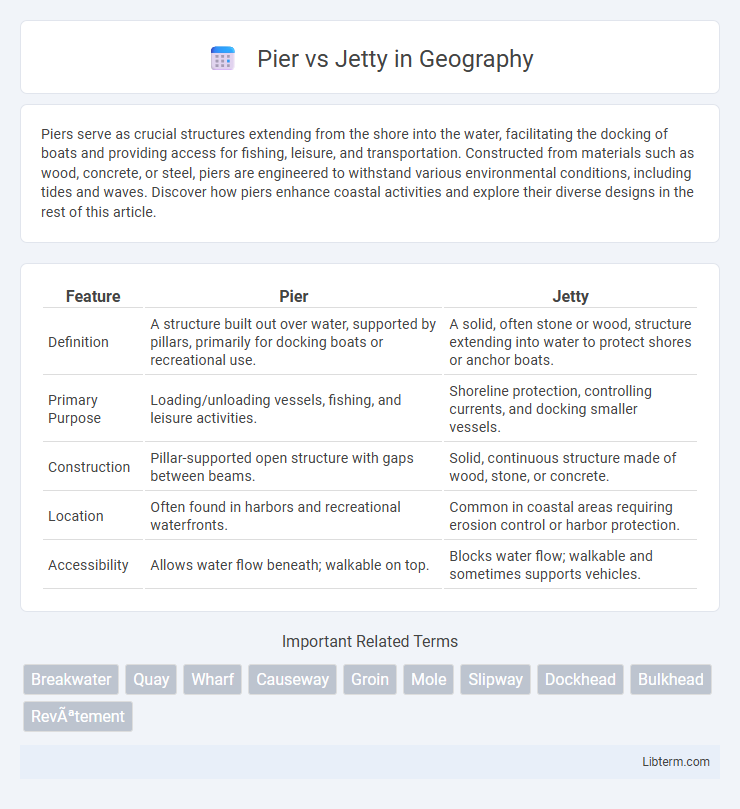Piers serve as crucial structures extending from the shore into the water, facilitating the docking of boats and providing access for fishing, leisure, and transportation. Constructed from materials such as wood, concrete, or steel, piers are engineered to withstand various environmental conditions, including tides and waves. Discover how piers enhance coastal activities and explore their diverse designs in the rest of this article.
Table of Comparison
| Feature | Pier | Jetty |
|---|---|---|
| Definition | A structure built out over water, supported by pillars, primarily for docking boats or recreational use. | A solid, often stone or wood, structure extending into water to protect shores or anchor boats. |
| Primary Purpose | Loading/unloading vessels, fishing, and leisure activities. | Shoreline protection, controlling currents, and docking smaller vessels. |
| Construction | Pillar-supported open structure with gaps between beams. | Solid, continuous structure made of wood, stone, or concrete. |
| Location | Often found in harbors and recreational waterfronts. | Common in coastal areas requiring erosion control or harbor protection. |
| Accessibility | Allows water flow beneath; walkable on top. | Blocks water flow; walkable and sometimes supports vehicles. |
Introduction to Piers and Jetties
Piers and jetties are both structures extending from the shore into the water, primarily used for docking boats and controlling water flow. A pier is typically a raised platform supported by pillars, designed to provide access for pedestrians and vessels over water, often used in recreational, commercial, and fishing activities. Jetties are solid, embankment-like structures built to protect shorelines and harbors by controlling currents and preventing sediment buildup.
Defining Piers: Structure and Purpose
Piers are elevated platforms extending from the shore over water, supported by piles or pillars designed to withstand tidal forces and wave action. They serve multiple purposes such as providing docking space for boats, facilitating fishing activities, and supporting recreational amenities like walkways and seating areas. Structurally, piers are engineered to allow water flow beneath, minimizing environmental impact while enabling maritime and leisure functions.
Understanding Jetties: Design and Function
Jetties are elongated structures extending into water bodies, primarily designed to influence currents, control sediment deposition, and protect harbor entrances, facilitating safer navigation. Their construction typically involves durable materials like concrete, rock, or steel to withstand harsh marine conditions and reduce erosion. Understanding jetty design highlights their role in coastal engineering to manage sediment transport, prevent beach erosion, and maintain channel depth for maritime activities.
Key Differences Between Piers and Jetties
Piers are elevated structures extending from the shore into the water, primarily designed for docking boats, fishing, and recreational activities, while jetties are sturdy, often rocky or concrete, barriers built to protect shorelines and harbor entrances from sedimentation and wave erosion. Piers facilitate access over water for vessels and people by providing a stable platform, whereas jetties control water flow and help maintain navigable waterways by preventing sediment buildup. The key difference lies in their function: piers serve as access points, whereas jetties function as protective coastal engineering structures.
Historical Development of Piers and Jetties
Piers and jetties evolved as critical maritime structures with distinct historical roles; piers originated in ancient civilizations as platforms extending over water for docking and commerce, while jetties developed primarily to protect harbor entrances and control sediment flow. The historical construction of piers involved wood and stone materials, prominently seen in Roman and medieval ports, whereas jetties emerged in the 19th century with advances in engineering to safeguard navigable channels and reduce erosion. Both structures significantly influenced coastal trade and navigation, shaping the development of modern waterfront infrastructure worldwide.
Materials Used in Pier and Jetty Construction
Piers are commonly constructed using materials such as reinforced concrete, steel, and timber, chosen for their durability and ability to withstand heavy loads and marine conditions. Jetties often incorporate rock, rubble, and concrete to form robust structures that protect shorelines and navigation channels from erosion and wave impact. The material selection in both pier and jetty construction is critical to ensuring structural integrity and resistance to corrosive saltwater environments.
Environmental Impacts of Piers vs Jetties
Piers typically allow water and marine life to flow freely beneath, minimizing habitat disruption and sediment buildup, which often results in fewer negative environmental impacts compared to jetties. Jetties, constructed to stabilize shorelines and harbor entrances, can significantly alter natural water currents and sediment transport, leading to erosion or deposition that affects adjacent ecosystems. The interruption of sediment flow by jetties can degrade nearby habitats, causing loss of biodiversity and changes in coastal morphology.
Common Uses: Recreational, Commercial, and Navigational
Piers are commonly used for recreational activities such as fishing, sightseeing, and docking small boats, offering easy access to water for leisure purposes. Jetties primarily serve commercial and navigational functions, acting as protective structures that guide ships into harbors and prevent sediment buildup, ensuring safe passage for large vessels. Both piers and jetties support maritime operations, with piers leaning towards recreational uses and jetties providing essential infrastructure for commercial shipping and coastal protection.
Maintenance and Longevity Considerations
Piers typically require more frequent maintenance than jetties due to their complex structural elements exposed to varying water levels and weather conditions, leading to potential wear and corrosion. Jetties, constructed primarily for coastal protection and navigation, are often sturdier with fewer components, resulting in longer durability and lower upkeep costs. Choosing between a pier and a jetty depends on expected environmental stress, material quality, and usage intensity, which directly impact maintenance schedules and overall longevity.
Choosing Between a Pier and a Jetty: Factors to Consider
Choosing between a pier and a jetty depends on purpose, location, and environmental conditions. Piers are ideal for recreational use and boat docking, extending over water on pillars, while jetties serve as protective structures, often built from large rocks, to prevent sediment buildup and shield harbors from waves. Consider factors like water depth, wave activity, maintenance requirements, and intended use to make an informed decision.
Pier Infographic

 libterm.com
libterm.com